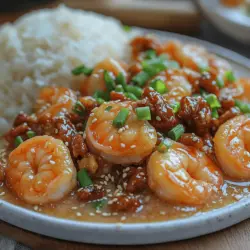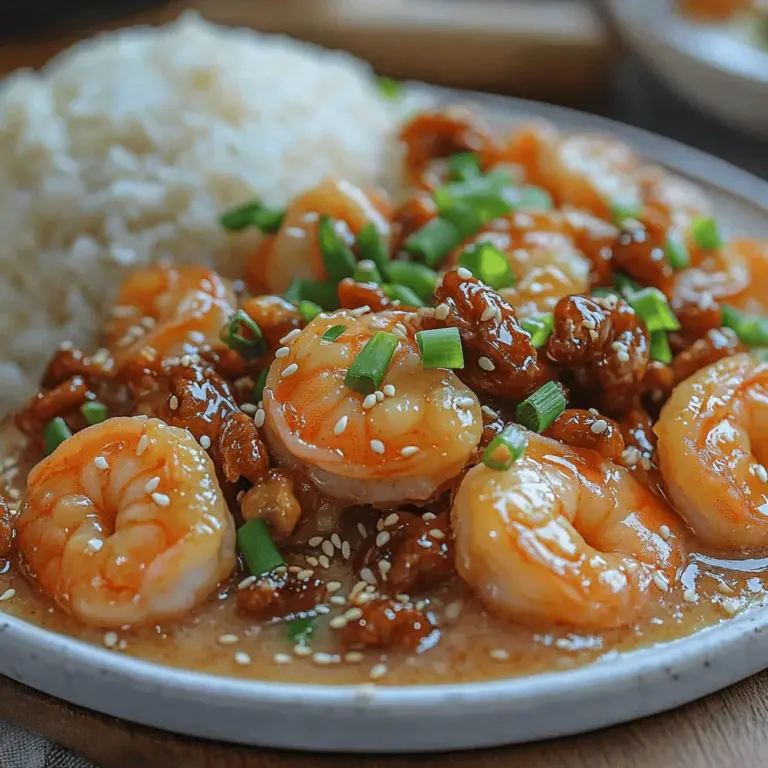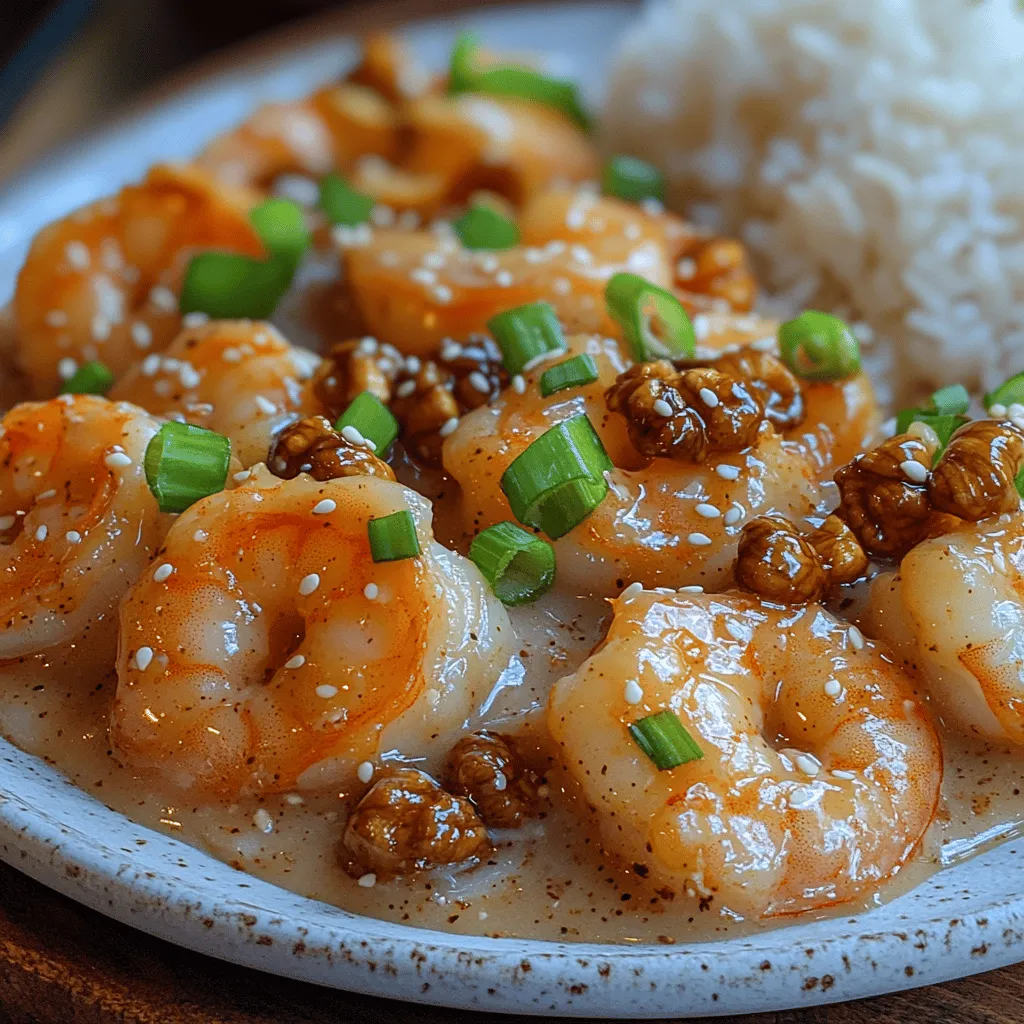Introduction
Honey Walnut Shrimp is a beloved dish that beautifully represents the fusion of Chinese and American culinary traditions. This dish has carved out a special place in the hearts of many food lovers, characterized by its delightful combination of flavors and textures. Imagine the sweetness of honey mingling with the rich crunch of toasted walnuts, all enveloping succulent shrimp. It’s a dish that not only satisfies the taste buds but also appeals to the senses with its vibrant presentation.
Often served in Chinese restaurants across the United States, Honey Walnut Shrimp has become a staple in family dinners and festive gatherings alike. Whether you’re celebrating a birthday, hosting a holiday meal, or simply indulging in a comforting weeknight dinner, this dish is a crowd-pleaser. Its versatility makes it suitable for various occasions, and its rich flavors invite everyone to come back for seconds.
The Allure of Honey Walnut Shrimp
Honey Walnut Shrimp holds a unique cultural significance within Chinese-American cuisine. The dish is believed to have originated in the United States, specifically in California, where chefs began to adapt traditional Chinese recipes to cater to American tastes. This adaptation resulted in a dish that is not only flavorful but also visually appealing, making it a favorite among diners.
The popularity of Honey Walnut Shrimp can be attributed to its harmonious balance of flavors. The sweetness of honey pairs perfectly with the creamy richness of mayonnaise and sweetened condensed milk, while the walnuts add a delightful crunch. The shrimp, when cooked to perfection, provides a tender and juicy contrast to the other elements on the plate. This intricate layering of flavors—from the umami of the shrimp to the sweetness of the sauce—creates a dish that is both satisfying and memorable.
In addition to its taste, Honey Walnut Shrimp showcases a beautiful presentation. The glistening sauce, the golden-brown walnuts, and the vibrant green garnishes come together to create a dish that is as pleasing to the eye as it is to the palate. This visual appeal has made it a popular choice not just in homes but also in restaurants, where it often features prominently on menus.
Ingredients Overview
To create the perfect Honey Walnut Shrimp, it’s essential to use high-quality ingredients that complement each other beautifully. Let’s take a closer look at the key components of this dish and their roles in achieving that signature flavor and texture.
Large Shrimp
The centerpiece of this dish is, of course, the shrimp. When selecting shrimp, freshness is paramount. Opt for large, plump shrimp that have a firm texture and a mild ocean scent. The size of the shrimp is important as it ensures that they will remain tender and juicy during cooking. For the best results, consider using shrimp that are deveined and peeled, as this will save time during preparation.
Walnuts
Walnuts play a crucial role in Honey Walnut Shrimp, contributing both flavor and crunch. Not only do they add a delightful texture to the dish, but they also come packed with nutritional benefits. Walnuts are rich in healthy fats, omega-3 fatty acids, and antioxidants, making them a heart-healthy choice. When caramelized, they develop a sweet, toasty flavor that elevates the overall dish.
Cornstarch
Cornstarch is the secret ingredient that helps achieve that coveted crispy batter on the shrimp. When coated in cornstarch before frying, the shrimp develop a light and crunchy exterior that contrasts beautifully with their tender interior. This technique is essential to ensure that the shrimp are not only flavorful but also texturally appealing.
Mayonnaise
While it may seem unconventional, mayonnaise is a key ingredient in the sauce that coats the shrimp. It lends a creamy richness that balances the sweetness of the honey and adds depth to the overall flavor profile. The combination of mayonnaise with other ingredients creates a luscious sauce that clings beautifully to the shrimp.
Honey
Honey is the star of the show when it comes to flavor. Its natural sweetness brings out the best in the other ingredients and provides a sticky glaze that enhances the dish’s appeal. The quality of the honey used can make a significant difference in the final taste, so consider using a high-quality, pure honey for the best results.
Sweetened Condensed Milk
Adding sweetened condensed milk to the sauce gives it an extra layer of creaminess and sweetness. This ingredient helps to mellow the flavors and creates a smooth, indulgent coating for the shrimp. The richness it imparts elevates this dish from simple to spectacular.
Vegetable Oil
Frying the shrimp requires a good quality vegetable oil that can withstand high temperatures. Peanut oil or canola oil are excellent choices due to their neutral flavor and high smoke points. Proper frying techniques are essential to achieve that crispy texture while preventing the shrimp from absorbing too much oil.
Garnishes
Lastly, garnishes such as chopped green onions and sesame seeds are vital for presentation. They not only add a pop of color but also contribute additional flavor and texture. A sprinkle of green onions provides a fresh, oniony bite, while sesame seeds add a nutty crunch that complements the walnuts perfectly.
Preparing the Walnuts
One of the essential steps in making Honey Walnut Shrimp is caramelizing the walnuts. This process enhances their flavor and adds a sweet crunch that is integral to the dish. Follow these step-by-step instructions to achieve perfectly caramelized walnuts.
1. Gather Your Ingredients: You will need walnuts, granulated sugar, and a pinch of salt.
2. Prepare Your Workspace: Line a baking sheet with parchment paper to catch the caramelized walnuts as they cool.
3. Melt the Sugar: In a medium saucepan, combine granulated sugar and a small amount of water over medium heat. Stir until the sugar dissolves, and then allow it to cook without stirring. Watch closely as the mixture begins to bubble and turn golden.
4. Monitor the Color: Once the sugar reaches a light amber color, add the walnuts to the pan. Stir quickly to coat them evenly in the caramel. It’s vital to work fast during this step, as the sugar can burn quickly.
5. Even Coating: Ensure that all walnuts are well-coated in the caramel. If you find that some are clumping together, gently separate them with a spatula.
6. Transfer and Cool: Pour the caramelized walnuts onto the prepared baking sheet, spreading them out to prevent sticking. Allow them to cool completely before using.
This technique not only enhances the flavor of the walnuts but also adds a beautiful golden hue that will make your Honey Walnut Shrimp visually appealing.
Preparing the Shrimp
Once your walnuts are ready, it’s time to prepare the shrimp. Properly coating the shrimp is crucial for achieving that signature crunch. Here’s how to do it:
1. Clean the Shrimp: If you haven’t done so already, rinse the shrimp under cold water and pat them dry with paper towels. This step is important for ensuring that the cornstarch adheres properly.
2. Season the Shrimp: In a bowl, season the shrimp with salt and pepper. This step enhances the flavor of the shrimp and ensures that every bite is delicious.
3. Coat with Cornstarch: Place cornstarch in a shallow dish. Working in batches, take a few shrimp and coat them evenly in the cornstarch, shaking off any excess. This thin layer will create that crispy exterior when fried.
4. Heat the Oil: In a deep frying pan or wok, heat vegetable oil over medium-high heat. To test if the oil is hot enough, drop a small piece of cornstarch into the oil; it should sizzle immediately.
5. Fry the Shrimp: Carefully add the coated shrimp to the hot oil in batches, making sure not to overcrowd the pan. Fry until the shrimp are golden brown and cooked through, about 2-3 minutes per side. Use a slotted spoon to remove the shrimp and transfer them to a paper towel-lined plate to drain any excess oil.
With the walnuts caramelized and the shrimp expertly prepared, you are well on your way to creating a dish that is both delicious and visually stunning. The next steps will guide you through the final assembly and sauce creation for your Honey Walnut Shrimp, ensuring that you achieve the perfect balance of flavors and textures. Stay tuned for the completion of this delectable recipe.
Techniques for Evenly Coating Shrimp for Optimal Frying
Achieving a perfect coating on your shrimp is crucial for that crunchy texture that defines Honey Walnut Shrimp. Start by ensuring that your shrimp are thoroughly dried after rinsing; excess moisture can prevent the batter from adhering properly. Pat the shrimp dry with paper towels, which will help the coating stick and result in a crispier finish.
When preparing your batter, consider using a mixture of cornstarch and all-purpose flour. This combination not only provides a light, airy coating but also enhances crunchiness. Dip each shrimp into the batter, ensuring they are completely covered. To avoid clumping, shake off any excess batter before frying. For an extra layer of crunch, consider double-dipping: first coat the shrimp in the batter, then dip them again in a light layer of cornstarch before frying.
Crafting the Sauce
The honey sauce is the heart of this dish, bringing together a medley of flavors that elevate the shrimp to new heights. To make the sauce, combine mayonnaise, honey, sweetened condensed milk, and lemon juice in a bowl. This blend creates a creamy, sweet, and tangy sauce that perfectly complements the savory shrimp.
1. Mayonnaise serves as the creamy base, adding a rich texture.
2. Honey contributes natural sweetness, harmonizing with the shrimp.
3. Sweetened condensed milk enhances the overall sweetness while adding a velvety mouthfeel.
4. Lemon juice balances the flavors with a touch of acidity, cutting through the richness.
For the right consistency, ensure the sauce is smooth but not too runny; it should cling to the shrimp without sliding off. If necessary, adjust the thickness by adding more mayonnaise for creaminess or a splash of lemon juice for tanginess. Taste as you go to achieve the perfect balance of flavors.
Frying the Shrimp Perfectly
Frying your shrimp correctly is crucial for achieving that delightful crunch. Use a heavy-bottomed skillet or a deep fryer to maintain consistent oil temperature. Heat the oil to 350°F (175°C) for optimal frying; too low and the shrimp will absorb excess oil, becoming greasy, while too high can lead to burnt batter.
To ensure even cooking, fry the shrimp in batches, allowing enough space for each piece to float freely. This prevents overcrowding, which can lower the oil temperature, resulting in soggy shrimp. Fry each batch for about 2-3 minutes or until golden brown, turning them halfway through to ensure they cook evenly on all sides. Use a slotted spoon to transfer the fried shrimp to a paper towel-lined plate to drain excess oil.
Combining Shrimp and Sauce
Once your shrimp are perfectly fried, it’s time to combine them with the honey sauce. In a large mixing bowl, add the fried shrimp and pour the honey sauce over them. Using a spatula, gently toss the shrimp in the sauce to ensure they are evenly coated. Be careful during this process; overmixing can break the shrimp and compromise their texture. The goal is to coat each piece delicately so that the sauce clings without ruining the crispy exterior.
Adding the Crunch: Incorporating Walnuts
The final touch to your Honey Walnut Shrimp is the addition of caramelized walnuts, which add both texture and flavor. To prepare the walnuts, toast them in a dry skillet over medium heat until golden brown. Next, you can caramelize them by adding a tablespoon of sugar and a splash of water, stirring until the sugar dissolves and coats the walnuts.
Once the walnuts are ready, fold them into the shrimp and sauce mixture gently. This step is crucial; you want the walnuts to be evenly distributed without crushing them. The goal is to maintain their crunch while ensuring every bite of shrimp has a delightful walnut surprise.
Serving Suggestions
Presentation is key when serving Honey Walnut Shrimp. For an elegant touch, serve it over a bed of steamed jasmine or basmati rice, which absorbs the sauce beautifully. You can also arrange the shrimp on a platter, garnishing with sesame seeds or sliced green onions for added color and flavor.
This dish works wonderfully as an appetizer or a main course. If serving it as part of a larger meal, consider pairing it with stir-fried vegetables or a light salad to balance the richness of the shrimp.
Garnishing options can enhance both the visual appeal and flavor profile. Fresh cilantro or parsley adds a pop of color, while a sprinkle of crushed red pepper flakes can provide a hint of heat, complementing the sweetness of the dish.
Nutritional Information
The nutritional content of Honey Walnut Shrimp varies based on portion size and specific ingredients used. On average, a serving (about one cup) contains approximately 400-500 calories. Key nutrients include:
– Protein: Shrimp is an excellent source of high-quality protein, essential for muscle repair and growth.
– Omega-3 Fatty Acids: These healthy fats in shrimp contribute to heart health.
– Vitamins and Minerals: Shrimp provides important nutrients like vitamin B12, iron, and selenium.
Walnuts are also nutrient-dense, providing healthy fats, antioxidants, and fiber. However, due to their caloric density, it’s important to practice portion control, especially since the caramelization process can add extra sugar.
Conclusion
Making Honey Walnut Shrimp is a delightful culinary experience that brings together a symphony of flavors and textures. The sweet, crunchy shrimp paired with the creamy honey sauce and the added crunch of walnuts creates a dish that is not only visually appealing but also incredibly satisfying.
This recipe’s versatility allows it to shine on various occasions—whether as a festive main course or an elegant appetizer. Once you master the techniques of coating, frying, and combining, you’ll find yourself eager to share this dish with family and friends.
We encourage you to try your hand at making this delicious Honey Walnut Shrimp, savoring the sweet and crunchy flavors that make it such a beloved dish. Your taste buds will thank you, and it may just become a new favorite in your culinary repertoire. Enjoy the process and the delightful results!


